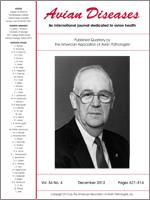Mycoplasma synoviae (MS) continues to cause significant losses to poultry producers, and studying the epizootiology of infection is an important component of MS control. The partial variable lipoprotein hemagglutinin A (vlhA) gene is the only genomic target identified so far for MS sequence typing. The vlhA gene codes for two variable cell surface proteins, lipoprotein and hemagglutinin, and the proposed mechanism for the variation is gene conversion between a single expressed gene and an array of pseudogenes. The upstream portion of the vlhA gene is present in the genome in a single copy (not present in the pseudogenes), and it is the only part of the gene that can be used for targeted sequence typing. However, the 3′ end of the vlhA “single copy” as well as this region's discriminatory potential for genotyping purposes has not been established. The purpose of this study was to identify the exact limit and the genotyping potential of the vlhA single copy region. New PCR assays were developed to amplify the entire conserved region and part of the variable region of the vlhA gene. Amplification and sequencing were performed on a variety of MS samples and on in vitro sequential generations of a standard MS strain. Sequence analyses determined the site and composition of the most proximal sequence variation that could be attributed to a gene conversion event, and they predicted the end point of the vlhA single copy region. The results indicated that a currently available “revised Hammond” PCR spans the whole single copy of the vlhA gene and exploits the full genotyping potential of this MS genomic target. In addition, this study allows interesting insight into the gene conversion mechanism of MS and offers the opportunity for further investigation this mechanism in mycoplasmas.
BioOne.org will be down briefly for maintenance on 17 December 2024 between 18:00-22:00 Pacific Time US. We apologize for any inconvenience.
How to translate text using browser tools
1 December 2012
The Genotyping Potential of the Mycoplasma synoviae vlhA Gene
Mohamed M. El-Gazzar,
Amy N. Wetzel,
Ziv Raviv
ACCESS THE FULL ARTICLE

Avian Diseases
Vol. 56 • No. 4
December 2012
Vol. 56 • No. 4
December 2012
gene conversion
genotyping
Mycoplasma synoviae
PCR
vlhA gene




